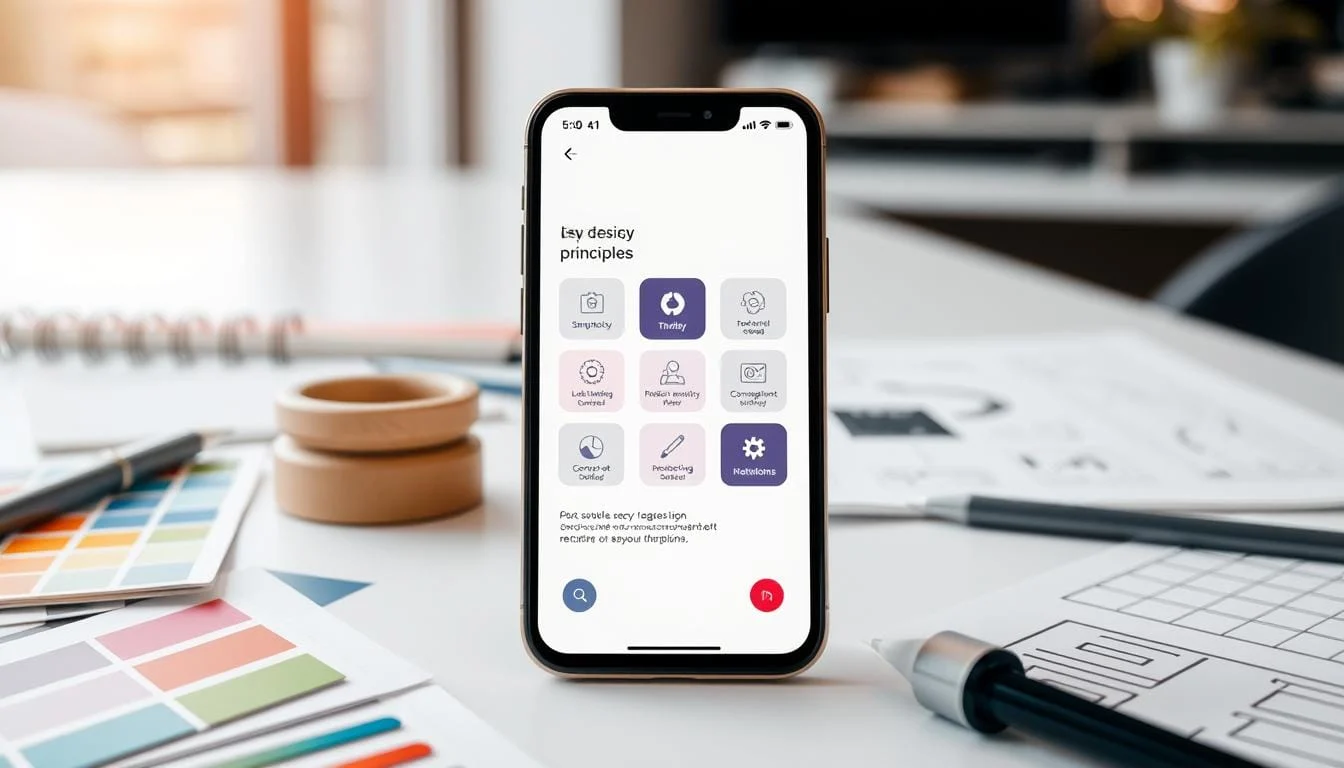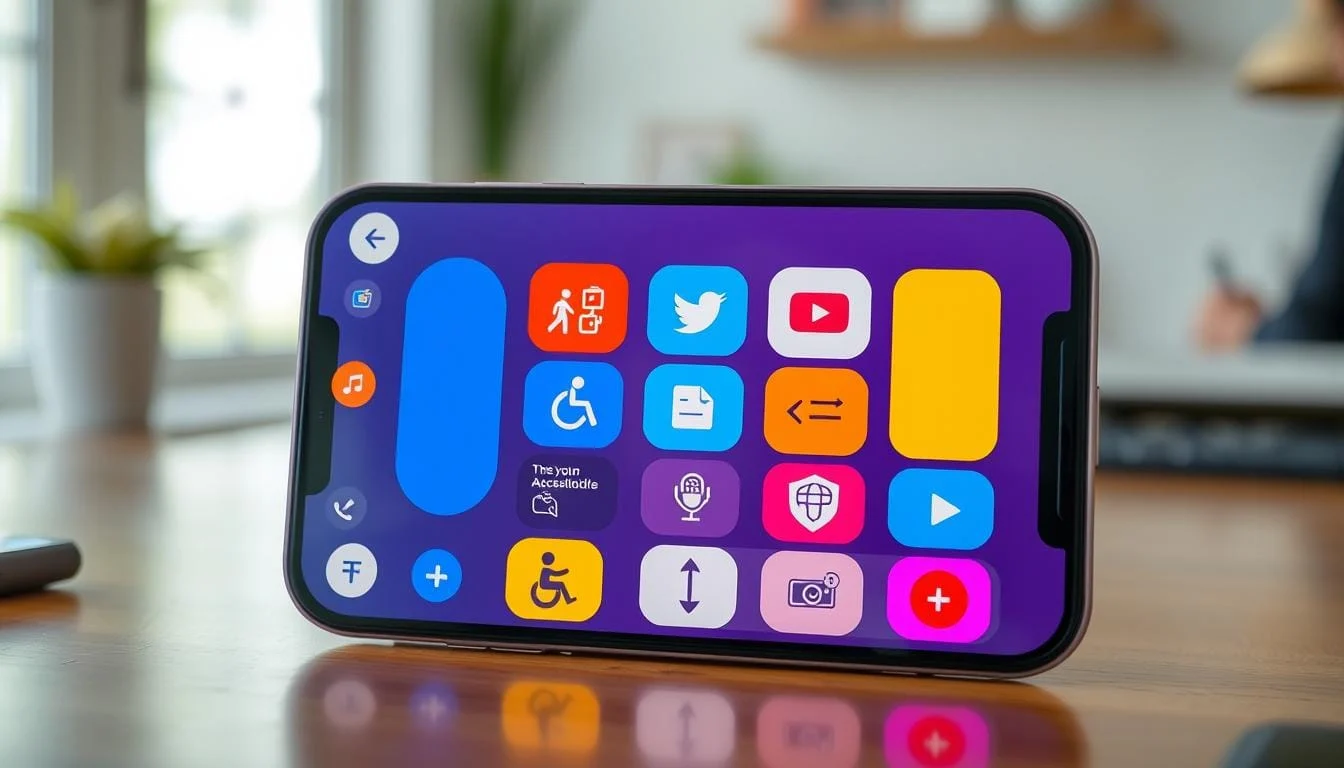Ever wondered why some mobile apps are easy to use while others are not? The answer is in the UI design. Good UI design makes an app great, changing how users interact with it.
In today’s fast world, good UI design is key to success. It’s not just about looks; it’s about making the app easy and fun to use. Every detail, from layout to color, affects the user’s experience.

Mobile app design is both art and science. It involves understanding users, keeping things simple, and testing often. Whether for iOS or Android, the UI design principles stay the same, with some differences.
Want to improve your app design skills? Let’s look at the key principles for a standout mobile app interface. Great UI design creates experiences users love and return to.
Key Takeaways
- User-centric design is crucial for mobile app success
- Effective UI enhances user engagement and satisfaction
- Understanding platform-specific guidelines is essential
- Accessibility should be a top priority in UI design
- Continuous learning and testing are key to great UI design
- Emerging trends like AR and dark mode are shaping the future of UI
Ready to bring your app ideas to life? Hire a skilled freelance mobile app developer on Fiverr to make your UI design vision real.
Understanding Mobile App UI Design Fundamentals
Mobile app interface design is key to making apps successful. It’s important to know the basics that make mobile UIs effective and easy to use.
Defining UI Design for Mobile Applications
UI design for mobile apps aims to create beautiful and easy-to-use interfaces. It covers the app’s look, feel, layout, colors, and how it interacts with users. Designing for mobile means thinking about small screens and touch interactions.
Key Components of Mobile App Interfaces
Good mobile UI design has several important parts:
- Layout and visual hierarchy
- Navigation patterns
- Color schemes and typography
- Interactive elements (buttons, forms, etc.)
- Responsive design for various screen sizes
The Impact of UI Design on User Experience
A well-designed mobile UI greatly improves user experience. It can make users happier, keep them using the app longer, and help the app succeed. Here are some interesting stats:
| Aspect | Impact |
|---|---|
| Global smartphone users | 14.1 billion in 2021 |
| Mobile app downloads | 350 billion in 2021 |
| Preferred screen orientation | 94% use portrait mode |
To make a top-notch mobile app interface, you might need some help. Look for skilled freelancers on Fiverr.com to help bring your design to life.
The Importance of User-Centric Design in Mobile Apps
User-centric design is key to making mobile apps successful. It focuses on the user experience, making apps easier and more appealing. This leads to more users enjoying the app and better success.
By focusing on user interface design, you create an app that meets user needs. In fact, 80% of users will stick with an app that fits their preferences. This focus can increase user engagement by 25%.
Here are some benefits of user-centric design:
- 50% higher retention rates through usability testing
- 40% decrease in abandonment rates
- 30% more user engagement through personalization
- 60% higher brand loyalty with tailored experiences
Doing user research before starting can make users 20% happier. This makes the app easy and fun to use.
“User-centric design is not just about making things look pretty. It’s about creating an experience that solves real problems for real people.”
To do user-centric design well, try these strategies:
| Strategy | Impact |
|---|---|
| Conduct usability testing | Reduces app abandonment by up to 60% |
| Implement personalization | Increases user engagement by 30% |
| Focus on intuitive navigation | Improves traffic retention rates |
| Gather and act on user feedback | Results in more polished app designs |
By focusing on user-centric design, you’re not just making an app. You’re creating an experience that users will love and come back to. Ready to make your app idea a reality? Hire a skilled freelancer to help you create a standout user-centric mobile app.
Essential Elements of Effective Mobile UI Design
Creating a good ui for your ios app or android application requires careful consideration of design elements. Mobile ui design plays a crucial role in app development, impacting user satisfaction and overall success. Let’s explore key components that make up an effective app user interface design.
Layout and Visual Hierarchy
A well-structured layout guides users through your app seamlessly. Organize content in a clear visual hierarchy, placing important information at the top. Use whitespace effectively to prevent clutter and improve readability. Remember, 53% of users abandon mobile sites or apps that take over three seconds to load, so keep your design clean and efficient.

Navigation Patterns and Structures
Intuitive navigation is vital for a positive user experience. Implement familiar patterns like tab bars or hamburger menus. Ensure that users can easily access key features and return to previous screens. Consistency in navigation across your app helps users feel comfortable and in control.
Color Theory and Typography in Mobile Interfaces
Colors and fonts greatly influence how users perceive and interact with your app. Choose a color scheme that aligns with your brand and enhances readability. Select fonts that are easy to read on small screens. Maintain consistency in your color and typography choices throughout the app to create a cohesive look and feel.
| Design Element | Impact on User Experience | Best Practice |
|---|---|---|
| Layout | Guides user attention | Use clear visual hierarchy |
| Navigation | Improves app usability | Implement familiar patterns |
| Color | Influences user perception | Choose brand-aligned scheme |
| Typography | Affects readability | Select legible fonts |
Incorporating these essential ui design principles can significantly enhance user satisfaction and drive app downloads. For expert guidance in mobile app development, hire a skilled freelancer to bring your app vision to life.
Mobile App User Interface Design: Principles and Best Practices
Designing a mobile app requires following key principles and best practices. UI designers and app designers should focus on simplicity, consistency, and clarity. This ensures a smooth user experience.

User research is vital in understanding how people use mobile apps. With over 5 billion daily users, designing for diverse needs is crucial. A well-designed UI can greatly improve user satisfaction and app adoption.
“95% of users judge the credibility of a business based on its mobile app design.”
Here are some best practices for creating effective UI elements:
- Optimize for touch interactions
- Prioritize content hierarchy
- Ensure consistent design across screens
- Provide clear feedback for user actions
- Design for one-handed use
When designing for ui and ux, remember that 80% of users value ease of navigation. By following these principles, you can make a mobile app that looks and works great. If you need to hire skilled mobile app designers, look for professional platforms for top talent.
| Design Principle | Impact on User Experience |
|---|---|
| Simplicity | 30% increase in user adoption rates |
| Consistency | 75% of users prefer consistent design elements |
| Fast Loading | 70% of users expect apps to load within 2 seconds |
| Accessibility | 40% increase in user engagement |
By following these principles and best practices, you can make a mobile app that shines in the crowded app market. With over four million apps on iOS and Android, standing out is key.
Designing for Different Mobile Platforms: iOS vs. Android
When making your app, it’s key to think about the design needs of iOS and Android. Each system has its own rules that affect how your app looks and how users act. Let’s look at the main differences and how to make your app easy to use on both.

Platform-specific Design Guidelines
iOS likes a simple design that focuses on what works well. Android’s Material Design is all about depth and movement. To make a good app, you must get these differences.
| Feature | iOS | Android |
|---|---|---|
| Minimum tap target size | 44×44 pt | 48×48 dp |
| Main app navigation | Bottom nav | Tabs at top of screen |
| Primary action placement | Top nav, right side | Floating action button |
| Single-choice lists | List with checkmark | Radio button list |
Adapting UI Elements for Different Operating Systems
When designing, think about how UI elements change between platforms. For example, iOS uses a picker for a few choices, while Android likes dropdowns or dialogs. These small changes can really affect how easy your app is to use.
Ensuring Consistency Across Platforms
Even as you follow each platform’s rules, keep your brand’s look the same. Use a cloud-based design tool to keep colors, fonts, and overall style the same on both apps. This way, your app feels the same no matter where it’s used.
Need help with designing for both platforms? Find a skilled freelancer to make your app look great on iOS and Android.
Prototyping and Iterative Design in Mobile UI Development

Prototyping is key in mobile app design. It lets developers make interactive models and test ideas. This helps make sure the app is easy to use and meets user needs.
The design process keeps improving with user feedback. This way, problems with usability are found early. With most people using apps, getting the design right is vital for success.
Benefits of Prototyping in Mobile UI Design
- Early identification of design flaws
- Improved resource management
- Faster development cycles
- Enhanced user experience
Most successful app developers see prototyping as essential. It helps avoid expensive changes by over 50%. This method follows design guidelines, making development smoother.
Tools like Axure, InVision, or Justinmind help visualize app designs. They let developers test and improve designs fast. This leads to more innovative and user-focused designs.
“Prototyping is not just about creating a model; it’s about learning and refining our understanding of user needs.”
The mobile app market is always changing. With so many apps, a good design is crucial. Using prototyping and iterative design can help your app stand out.
Need help with your mobile app UI design? Hire a skilled freelancer to bring your app vision to life.
Accessibility and Inclusivity in Mobile App Interfaces
Creating inclusive mobile apps is key to reaching more people. The design process should focus on accessibility. This ensures everyone can use your app’s features. Let’s look at how to make your app more inclusive.
Designing for Users with Disabilities
When designing your app, think about users with different disabilities. Add features like adjustable text sizes and high contrast options. These not only make your app easier to use but also make it look better.

Implementing Accessibility Features
Make sure your app works with screen readers. Use clear navigation and ensure all interactive parts are easy to tap. These steps make your app friendly for everyone.
Testing for Inclusive User Experiences
Testing is crucial for an inclusive app design. Get feedback from diverse groups to find and fix accessibility issues. This feedback loop helps make your app accessible to all.
| Accessibility Feature | Benefit | Implementation |
|---|---|---|
| Adjustable Text Size | Improves readability | Add text scaling option in settings |
| High Contrast Mode | Enhances visibility | Include alternative color schemes |
| Voice Commands | Enables hands-free use | Integrate voice recognition technology |
By focusing on accessibility, you’re not just following best practices. You’re also making your app more accessible to everyone. Need help? Hire a skilled freelancer to improve your app’s accessibility today.
Emerging Trends in Mobile App UI Design
The world of mobile app design is changing fast. New trends are shaping how we use our devices. Let’s look at some exciting changes in ios app design and more.
Dark mode is becoming popular. It cuts down eye strain and saves battery on OLED screens. Now, many apps offer dark mode, making them better in low light.
Voice user interfaces are also on the rise. With 150 million users expected to use voice assistants in 2022, adding this feature makes apps more accessible.
Responsive design is key for mobile. 74% of visitors might return to a site with good mobile UX. This shows how important it is to have easy-to-use interfaces.
Artificial intelligence is changing app design. By 2023, AI market revenue could hit $97.9 billion. AI can learn user habits, offer personalized content, and automate tasks, improving the app experience.
For language learning apps, using these trends can really help. Think about using AI for custom lessons or voice recognition for practice.
| Trend | Impact | Adoption Rate |
|---|---|---|
| Dark Mode | Reduced eye strain, improved battery life | High |
| Voice UI | Enhanced accessibility, hands-free interaction | Growing |
| AI Integration | Personalized content, automated tasks | Increasing |
To keep up with these changes, consider hiring a skilled mobile app designer. They can make these trends work in your next project.
Tools and Resources for Mobile UI Designers
Creating engaging mobile apps needs the right tools and resources. Let’s look at some popular options to help you make great UI designs. You’ll also learn more about app development.
Popular Design Software for Mobile Interfaces
Using top-rated design tools can greatly improve your workflow. Figma and InVision are at the top with ratings of 4.7/5 and 4.4/5. These tools have strong features for creating ui patterns and designing interfaces that connect with mobile users.
| Tool | Rating | Starting Price |
|---|---|---|
| Figma | 4.7/5 | Free for individuals |
| Sketch | 4.5/5 | $9/month per editor |
| Adobe XD | 4.5/5 | $9.99/month |
| Axure RP | 4.6/5 | $25/month per user |
UI Kits and Design Systems
UI kits and design systems make your work easier when creating a popular app. They offer pre-made components that follow design principles for various platforms. This ensures your app’s interface looks consistent, even when iOS and Android design principles differ.
Online Learning Resources and Communities
Online resources are key to keeping up with mobile UI design trends. Udemy and Coursera offer courses to improve your app design skills. Design communities offer networking and knowledge sharing. For team growth, hiring skilled web app developers can bring new ideas to your projects.
“A $10,000 investment in design-centric companies over 10 years would have yielded returns 228% greater than the same investment in the S&P.” – Design Management Institute
This shows the value of investing in good design for your app’s success. By using these tools and resources, you’re on the path to creating a standout mobile app in the competitive app market.
Conclusion
Mastering mobile app UI design is key in today’s digital world. With over 7 billion mobile users, making an effective app’s user interface is vital. The principles of mobile app design focus on user experience to make your app stand out.
User-centric design is crucial for successful mobile interfaces. By focusing on simplicity, responsiveness, and accessibility, you can create an app that users love. Apps like Netflix and Dropbox show how important consistency and intuitive navigation are.
To be great at mobile UI design, keep up with new trends and use platform-specific guidelines. Use prototyping tools for design improvements and test your app with users. By using hardware features and optimizing for performance, your app will look and work well on all devices.
Ready to improve your mobile app’s UI? Hire skilled UI designers on Fiverr.com to make your vision a reality. Create a mobile experience that truly engages your users.
FAQ:
For “Mastering Mobile App UI Design: Essential Principles for User Interface Success”
Q: What are the key principles of mobile app design?
A: The key principles of mobile app design include simplicity, consistency, intuitive navigation, visual hierarchy, responsive design, and user-centered approach. These principles help create a user-friendly interface that enhances user experience and improves user behavior within your app.
Q: How does the mobile app design process differ from traditional web design?
A: The mobile app design process focuses more on optimizing for smaller screens, touch interactions, and device-specific features. It requires careful consideration of user behavior on mobile devices, prioritizing essential functions of the app, and designing for various screen sizes and orientations to ensure a responsive design.
Q: What are some common UI design elements for mobile apps?
A: Common UI design elements for mobile apps include navigation bars, buttons, icons, forms, lists, cards, and gestures. These elements of mobile app design should be carefully crafted to create an intuitive and visually appealing interface that aligns with the app’s user interface design goals.
Q: How can I design a mobile app that stands out from competitors?
A: To design a mobile app that stands out, focus on creating a unique visual design, incorporating innovative features, and prioritizing excellent mobile user experience. Study successful mobile app design examples for inspiration, but ensure your app idea and interface design for mobile apps are distinctive and aligned with your target audience’s needs.
Q: What are some popular design tools for mobile app UI design?
A: Popular design tools for mobile app UI design include Sketch, Adobe XD, and Figma. Figma is a cloud-based design tool that allows for collaborative work and easy prototyping. These tools offer features specifically tailored for designing mobile app interfaces and creating interactive prototypes.
Q: How can I ensure my app design is user-friendly?
A: To ensure your app design is user-friendly, follow UI design principles such as maintaining consistency, using familiar patterns, providing clear feedback, and minimizing user input. Conduct user testing throughout the mobile app design process to gather feedback and iterate on your design based on real user behavior and preferences.
Q: What are some design tips for creating a language learning app?
A: When designing a language learning app, focus on creating an engaging and intuitive interface. Incorporate interactive elements, progress tracking, and gamification features. Ensure the app’s user interface design supports different learning styles and provides clear navigation between lessons and exercises. Consider using visual cues and audio elements to enhance the learning experience.
Q: How important is responsive design in mobile app development?
A: Responsive design is crucial in mobile app development as it ensures your app looks and functions well on various mobile devices and screen sizes. It helps maintain consistency in user experience across different platforms and improves overall usability. Implementing responsive design principles can lead to higher user satisfaction and better app performance.
Q: What are some common UI design mistakes to avoid when designing a mobile app?
A: Common UI design mistakes to avoid include cluttered interfaces, inconsistent design elements, poor typography choices, lack of visual hierarchy, and ignoring platform-specific guidelines. It’s also important to avoid overloading users with information and to ensure that all parts of your app are easily accessible and understood by the key user group.
Q: How can I incorporate user experience design principles in my mobile app interface?
A: To incorporate user experience design principles in your mobile app interface, focus on understanding your users’ needs and behaviors. Create user personas, conduct user research, and develop user journeys. Prioritize ease of use, accessibility, and user satisfaction throughout the design process. Regularly test and iterate your design based on user feedback to ensure a positive experience when using your app.
Source Links
- Effective UX design is crucial for creating engaging and user-friendly digital experiences.
- Master the art of mobile user interface design to captivate your audience on small screens.
- Elevate your app’s performance with expert iOS app user interface design.
- When it comes to mobile design, every pixel counts for user satisfaction.
- Help users understand the app quickly with intuitive and clear interface design.
- Apply common design patterns to create familiar and easy-to-navigate mobile interfaces.
- Thoughtful user interface design helps reduce friction and boost app engagement.
- A well-crafted UI can make the difference between app success and failure
- Let users instantly see the design value through a clean and intuitive interface.
- Designing a mobile app interface requires a perfect balance of form and function.
- Seamless design and development collaboration is key to creating outstanding mobile apps.
- Apply proven UX design principles to enhance user satisfaction and retention.
- Rigorous testing mobile app interfaces ensures a smooth user experience.
- Creating a mobile app that users love starts with exceptional UI/UX design.
- Embrace versatile design to accommodate various device sizes and orientations.
- Prototyping mobile interfaces allows for rapid iteration and improvement.
- Design consistently across all app screens to maintain a cohesive user experience.
- Master user interface design for mobile to stay ahead in the competitive app market.
- Consider using design systems to maintain consistency and efficiency in app development.
- Optimize interactions between the user and the app for a seamless experience.
This post contains affiliate links, which means I may earn a commission if you make a purchase through these links. There is no additional charge to you! Thank you for supporting my blog so I can continue creating free content each week!




